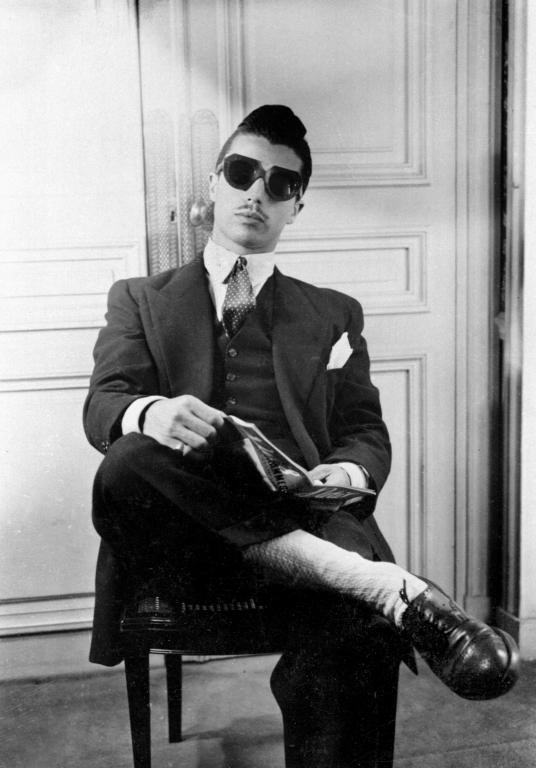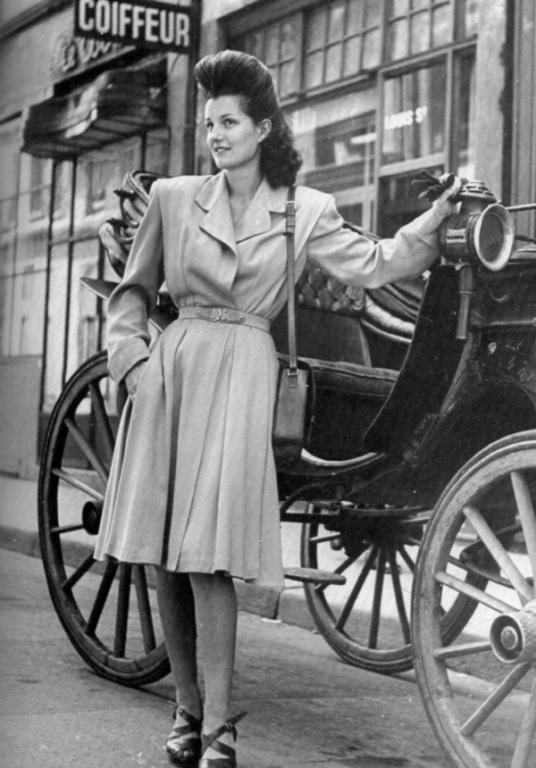An account of the French anti-Nazi cultural youth movement who opposed the Vichy regime in occupied France. Influenced by jazz and swing they met in basement clubs and scuffled with fascists on the streets.

French youth against the Nazis
In 1940, the Nazis had occupied France. The Vichy regime, in collaboration with the Nazis and fascist itself in policies and outlook, had an ultra-conservative morality and started to use a whole range of laws against a youth that was restless and disenchanted. In Paris, young people started meeting in cafes, passing their time mocking the politics of the time. This spontaneous development was a sharp response to the deadening effect on society of the Nazi-Vichy rule. They met in cinemas, in the cellar clubs and at parties arranged at short notice.
These young people, who called themselves Zazous, were to be found throughout France, but were most concentrated in Paris. The two most important meeting places of the Zazous were the terrace of the Pam Pam cafe on the Champs Elysees and the Boul’Mich (the Boulevard Saint-Michel near the Sorbonne).
The Zazous of the Champs Elysees came from a more middle class background and were older than the Zazous of the Latin Quarter. The Champs Elysees Zazous were easily recognisable on the terrace of the Pam Pam and took afternoon bike rides in the Bois de Boulogne. In the Latin Quarter, the Zazousmet in the cellar clubs of Dupont-Latin or the Capoulade.

The male Zazous wore extra large jackets, which hung down to their knees and which were fitted out with many pockets and often several half-belts. The amount of material used was a direct comment on Government decrees on the rationing of clothing material. Their trousers were narrow, gathered at the waist, and so were their ties, which were cotton or heavy wool. The shirt collars were high and kept in place by a horizontal pin. They liked thick-soled suede shoes, with white or brightly-coloured socks. Their hairstyles were greased and long.
In fact, after the Government decree of 1942, which authorised the collection of hair from barber-shops to be made into slippers, they grew their hair longer! In a parody of Englishness they carried formal ‘Chamberlain’ umbrellas, always neatly furled, and never opened in spite of rainy weather.
Syncopated
One fascist magazine commented on the male Zazou: “Here is the specimen of Ultra Swing 1941: hair hanging down to the neck, teased up into an untidy quiff, little moustache a la Clark Gable... shoes with too-thick soles, syncopated walk.”
Female Zazous wore their hair in curls falling down to their shoulders, or in braids. Blonde was the favourite colour, and they wore bright red lipstick, as well as sunglasses, also favoured by some male Zazous. They wore jackets with extremely wide shoulders and short, pleated skirts. Their stockings were striped or sometimes net, and they wore shoes with thick wooden soles.

The Zazous were big fans of checkered patterns, on jacket, skirt or brolly. They started appearing in the vegetarian restaurants and developed a passion for grated carrot salad! They usually drank fruit juice or beer with grenadine syrup, a cocktail that they seem to have invented.
The Zazous were directly inspired by jazz and swing music. A healthy, black jazz scene had sprung up in Montmartre in the inter-war years. Black Americans felt freer in Paris than they did back home, and the home-grown jazz scene was greatly reinforced by this emigration. Manouche Gypsy musicians like Django Reinhardt started playing swinging jazz music in the Paris clubs.
The Zazous probably got their name from a line in a song – Zah Zuh Zahby the black jazz musician Cab Calloway, famous for his Minnie the Moocher. A French crooner popular with the Zazous, Johnny Hess, also had a song, Je suis swing, in early 1942, in which he sung the lines “Za zou, za zou, za zou, za zou ze”. An associate of the Zazous, the anarchist singer/songwriter, jazz trumpeter, poet and novelist Boris Vian was also extremely fond of z words in his work! The long drape jacket was also copied from zootsuits worn by the likes of Calloway.
“The Zazous were very obviously detested by the Nazis, who on the other side of the Rhine, had since a long time decimated the German cultural avante garde, forbidden jazz and all visible signs of…degenerations of Germanic culture…”
- Pierre Seel, who, as a young Zazou, was deported to a German concentration camp because of his homosexuality
When the yellow star was forced on Jews, non-Jews who objected began to wear yellow stars with ‘Buddhist’, ‘Goy’ (Gentile) or ‘Victory’. Some Zazous took this up, with ‘Zazou’ written below the star. When the French Jews were removed from the scene, the Vichy regime and their Nazi masters turned on the Zazous.
Vichy had started ‘Youth Worksites’ in July 1940, in an attempt to indoctrinate French youth. The same year, they set up a Ministry of Youth. They saw the Zazous as a rival and dangerous influence on youth. By 1942, Vichy high-ups realised that the national revival that they hoped would be carried out by young people under their guidance was seriously affected by widespread rejection of the patriotism, work ethic, self-denial, asceticism and masculinity this called for. The Zazous were degenerate and dandified and so weren’t a lot of these scum obviously Jews?
The witch-hunt begins
In 1940, 78 anti-Zazou articles were published in the press, as opposed to nine in 1941 and 38 in 1943. The Vichy papers deplored the moral turpitude and decadence that was affecting French morality. Zazous were seen as work-shy, egotistical and Judeo-Gaullist shirkers.
Soon, round-ups began in bars and Zazous were beaten on the street. They became Enemy Number One of the fascist youth organisations, Jeunesse Populaire Française. “Scalp the Zazous!” became their slogan. Squads of young JPF fascists armed with hairclippers attacked Zazous. Many were arrested and sent to the countryside to work on the harvest.
At this point the Zazous went underground, holing up in their dance halls and basement clubs. With the Liberation of Paris it appears some Zazous joined in the armed combat to drive out the Nazis – certainly they had a few scores to settle. But the Zazous were suspected by the official Communist resistance of having a “couldn’t give a fuck” attitude to the war in general.
The Zazous were numbered in the hundreds rather than thousands and were generally between 17 and 20. There were Zazous from all classes but with apparently similar outlooks. Working class Zazous used theft of cloth and black market activities to get their outfits, sometimes stitching their own clothes. Some of the more bohemian Zazous in the Latin Quarter varied the outfit, with sheepskin jackets and multicoloured scarves. It was their ironic and sarcastic comments on the Nazi/Vichy rulers, their dandyism and hedonism, their suspicion of the work ethic and their love of ‘decadent’ jazz that distinguished them as one of the prototype youth movements questioning capitalist society.
Though they did not suffer like their contemporaries in Germany, the working class Edelweiss Pirates, some of whom were hanged by the Nazis, nevertheless, in a society of widespread complicity and acquiescence, their stand was courageous and trail-blazing.
Nick Heath
Taken from Organise! 59, the theoretical journal of the Anarchist Federation






Comments
Bump, because I've added a
Bump, because I've added a couple of photos.
Also, does anyone know exactly whereabouts on the Champs-Élysées the Pam Pam cafe was? As it would be good to geo-tag the exact location
It was on the corner where
It was on the corner where the Rue Lincoln joins the Champs Elysees.
Also see here:
https://lovemenuart.com/products/pam-pam-paris-1950s
This is an interesting read
This is an interesting read on the Vichy press and the Zazous:
https://www.brown.edu/Research/Equinoxes/journal/Issue%209/eqx9_seward.html
Parlez-Vous Zazou New song
Parlez-Vous Zazou New song and Video. https://youtu.be/mp6mczM5dBs